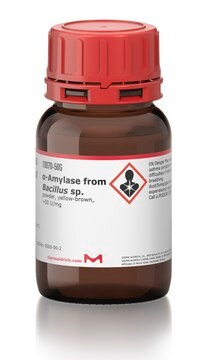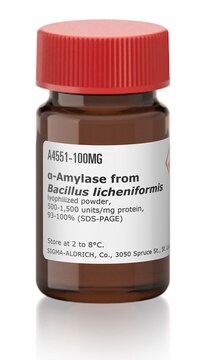A6380
α-Amylase from Bacillus sp.
Type II-A, lyophilized powder, ≥1,500 units/mg protein (biuret)
Sinônimo(s):
Alpha-Amylase, Glycogenase, 1,4-α-D-Glucan-glucanohydrolase
About This Item
Produtos recomendados
fonte biológica
bacterial (Bacillus amyloliquefaciens)
Nível de qualidade
tipo
Type II-A
Ensaio
≥30%
forma
lyophilized powder
atividade específica
≥1,500 units/mg protein (biuret)
peso molecular
50-55 kDa by SDS-PAGE
técnica(s)
SDS-PAGE: suitable
solubilidade
H2O: soluble 0.1 mg/mL, clear, colorless
adequação
suitable for hydrolysis, synthesis of oligosaccharides and polysaccharides, and sugar modification
aplicação(ões)
life science and biopharma
temperatura de armazenamento
−20°C
Procurando produtos similares? Visita Guia de comparação de produtos
Descrição geral
Aplicação
- as a component of salivary fluid to perform artificial mastication; in luminal gastrointestinal digestion experiment
- as a standard in sodium dodecyl sulfate-polyacrylamide gel electrophoresis (SDS-PAGE) to determine the concentration of α-Amylase
- to de-starch the alcohol insoluble residue (AIR) for non-cellulosic neutral monosaccharide analysis
Ações bioquímicas/fisiológicas
Características e benefícios
- α-Amylase from Bacillus licheniformis NCIB 6346 retains over 98% of its activity after 60 minutes at pH 6.2 and 85°C.
- Other α-Amylase maintain 100% of their activity after storage for 1 hour at 91°C.
Definição da unidade
Nota de preparo
Outras notas
substrato
Palavra indicadora
Danger
Frases de perigo
Declarações de precaução
Classificações de perigo
Resp. Sens. 1
Código de classe de armazenamento
11 - Combustible Solids
Classe de risco de água (WGK)
WGK 1
Ponto de fulgor (°F)
Not applicable
Ponto de fulgor (°C)
Not applicable
Equipamento de proteção individual
dust mask type N95 (US), Eyeshields, Faceshields, Gloves
Certificados de análise (COA)
Busque Certificados de análise (COA) digitando o Número do Lote do produto. Os números de lote e remessa podem ser encontrados no rótulo de um produto após a palavra “Lot” ou “Batch”.
Já possui este produto?
Encontre a documentação dos produtos que você adquiriu recentemente na biblioteca de documentos.
Os clientes também visualizaram
Nossa equipe de cientistas tem experiência em todas as áreas de pesquisa, incluindo Life Sciences, ciência de materiais, síntese química, cromatografia, química analítica e muitas outras.
Entre em contato com a assistência técnica










